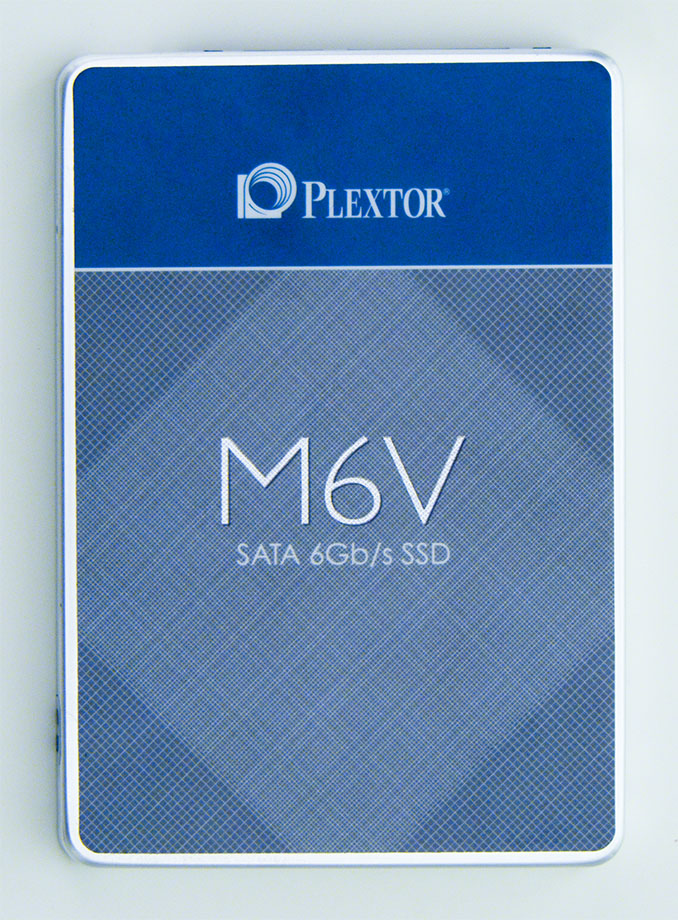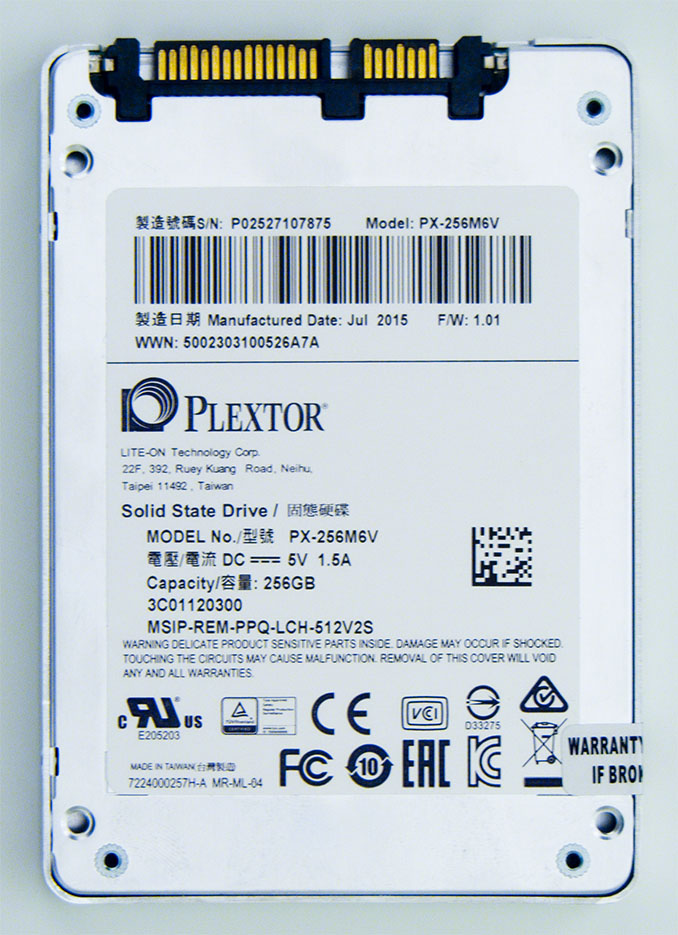The Plextor M6V (256GB) SSD Review
by Billy Tallis on October 12, 2015 8:00 AM ESTFinal Words
The value-oriented segment of the SSD market has a lot of great options at the moment for drives that don't have any critical weaknesses or major compromises relative to high-end SATA drives. This means that buying decisions will be driven almost entirely by the pricing of the moment. If priced properly, the Plextor M6V can be a great choice for general-purpose consumer use and especially for mobile use.
From a technical perspective, the most interesting aspect of the M6V is its Toshiba 15nm MLC NAND, as this is the only SM2246EN-based drive using it. Toshiba's 15nm MLC NAND seems to be a bit slower than the Micron 16nm MLC used in its closest relatives/competitors, but at the same time the M6V uses a bit less power. These differences are measurable, but probably not meaningful in the real world. The Plextor M6V and Crucial BX100 are about as close to interchangeable as drives can be without being clones that differ by only their label. The BX100's partial power loss protection may be important to some consumers but it's usually not a requirement in this market segment, and SM2246EN drives have not had any notable reliability issues.
| Amazon Price Comparison (10/12/2015) | ||||
| Drive | 120/128GB | 240/250/256GB | 500/512GB | 960GB/1TB |
| ADATA Premier SP610 | $49.99 | $84.99 | $223.44 | $379.99 |
| Transcend SSD 370 | $57.99 | $89.99 | $169.99 | $328.46 |
| Mushkin Reactor | - | - | - | $353.99 |
| Crucial BX100 | $61.99 | $79.99 | $159.99 | $314.99 |
| Plextor M6V | $65.99 | $99.99 | $189.99 | - |
| OCZ Trion 100 | $59.95 | $75.00 | $158.99 | $349.90 |
| Samsung 850 EVO | $64.00 | $89.24 | $168.63 | $343.24 |
Unfortunately, the current pricing on the Plextor M6V is simply too high in a crowded market. It's undercut by the Crucial BX100 and Samsung 850 EVO at every capacity point, and even the older SM2246EN drives using 20nm MLC are cheaper. Crucial and Samsung have the advantage of in-house NAND manufacturing, but the other competitors are just as much at the mercy of their NAND supplier as Plextor. In the long run the Toshiba 15nm MLC in the M6V ought to allow Plextor to beat ADATA and Transcend on price thanks to its greater density, but at these prices Toshiba and Plextor aren't there yet.
Ultimately if the high price is due to limited supply of the 15nm MLC, there may be significant price cuts further down the road as they get production ironed out. For now, although the M6V is as solid as any of the other SM2246EN drives, overall the BX100 remains the better value. Otherwise Plextor still has a hand to play in the market for smaller form factors; if the mSATA and M.2 variants of the M6V show up along with more reasonable pricing, they'll be very compelling for power-sensitive uses, as the BX100 is only available in the 2.5" form factor.












51 Comments
View All Comments
Vepsa - Monday, October 12, 2015 - link
Because not everyone needs or can afford a PCIe SSD. Or they have a computer that can't boot from one. I'd love two 250GB SSDs for my home server, but they have to be SATA or SAS because all its PCIe slots are full.Mr Perfect - Monday, October 12, 2015 - link
Yes, SATA it's still quite relevant. It's not exciting, but we can all use them.hyno111 - Monday, October 12, 2015 - link
There are currently no consumer PCIe SSD for laptops. SM951s are for OEM and may have trouble finding warranty. 950 pro is not out yet.Not to mention prices..
close - Monday, October 12, 2015 - link
So it's integrated GPU if you want power savings and Titan X SLI if you want performance. Nothing in between?There are shades of gray (maybe less than 50 are distinguishable though). Where do I fit a PCIe SSD? Unless it's a PCIe card then it's out. Also the price is a downer as while it may bring huge performance benefits, they don't justify the price for most users.
And don't forget that *any* computer out there will hugely benefit from even a cheap SSD while upgrading from that cheap SSD to an expensive one upgrading will bring less impressive improvements.
xenol - Monday, October 12, 2015 - link
The practical performance for many operations on secondary memory do not make anything beyond a SATA based SSD worthwhile. Go look up anecdotal reviews of RAM Drives, and you'll find many operations, despite RAM Drives offering orders of magnitude better performance, offer at best 10% better performance. Is it worth spending nearly twice as much on a PCIe drive than it is to get an SSD with double the capacity for what amounts to a 10% performance increase? No.Also, most storage operations that happen during regular use of a PC are very tiny. Most of them are <128KB in size. At that point, bandwidth is insignificant, but latency is what matters. And that's where SSDs really shine over HDDs.
Impulses - Monday, October 12, 2015 - link
It's all relative, there's plenty of common content creation scenarios where a PCI-E SSD makes a big big difference... Whether it's worth it or not is pretty subjective.Enthusiasts used to pay for stuff lime Raptor where the difference was relatively minor by comparison... Small (256GB) SM951 for me right now for the OS/apps, 2x1TB 850 EVOs for most else, why make it either/or? (on a desktop anyway)
xenol - Monday, October 12, 2015 - link
If you're on an unlimited budget, then sure, go spend money on the bestest thing possible.But if you're on a limited budget, sacrificing a few things here and there because they don't add much to the pie are the decisions you have to make. If you're a gamer, PCIe SSDs are worthless. Go spend the difference on a better video card. If you're a content creator, it still depends on the content being created. The only time I can ever see a high speed SSD as necessary is if you're dumping a ton of data from somewhere. Otherwise, just throw more RAM at the problem. Besides that, the CPU is probably still the biggest bottleneck in those scenarios (a year or two ago, someone mentioned that Intel's Ivy Bridge E was the only part he could find that could do a 1:1 BD-ROM rip and encode, which means for a 2 hour video and assuming the entire 25GB was used, the CPU was pumping out ~120MB/s... You can easily sustain that on a hard drive)
StrangerGuy - Tuesday, October 13, 2015 - link
Define "enthusiasts". Long ago during Raptor days there were also a huge mass of so-called "enthusiasts" who recommended against Raptors because they were a big stinking waste of money compared to regular 7200 rpm drives. Enthusiasts aren't people who will mindlessly throw good money for some ultra niche hardware they don't need despite what you want us believe.name99 - Monday, October 12, 2015 - link
Oh don't be narrow-minded.In just the last month I have
(a) replaced the HD in a friend's old MacBook Pro with an SSD (to speed up the machine)
(b) had the HD in my 3-yr old iMac fail (not exactly fail, but enough SMART warnings that it's time to stop gambling on it staying alive), so I switched to booting off a 1TB SSD stuck in a USB-3 enclosure.
Both of these were perfect use cases for a SATA SSD...
Coup27 - Monday, October 12, 2015 - link
What on earth are you smoking? (dj_aris)